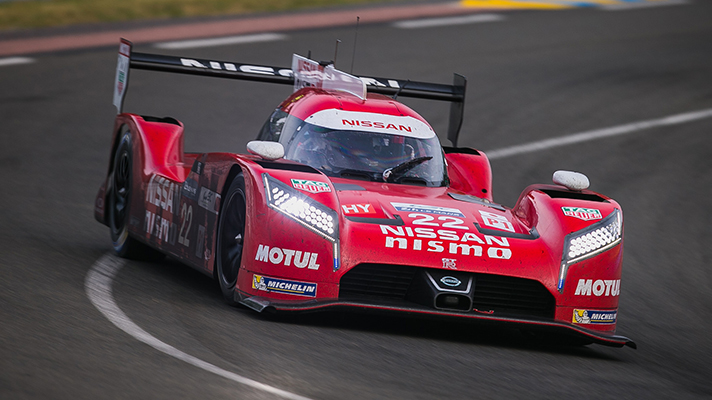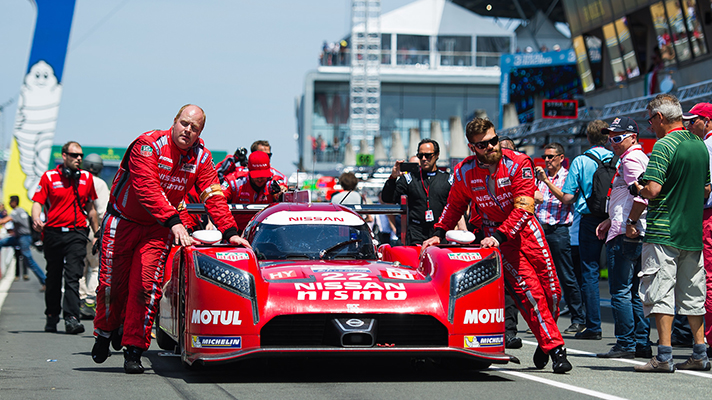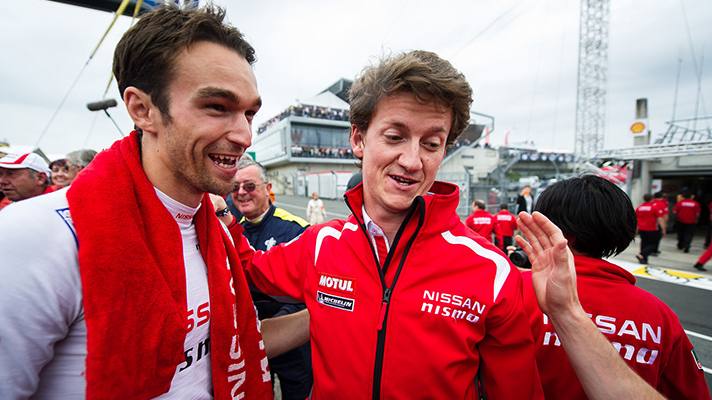
Nissan at Le Mans: what happened?
We watched the Nismo GT-R’s 24-hour debut from the pit lane. Here’s what we found out…
In May 2014, Nissan announced its return to the top tier of Le Mans racing, with a revolutionary, apparently back-to-front LMP1 hybrid.
Fast-forward a year and a bit. It's 3pm on the Sunday of Le Mans 2015, and one of the three GT-R LM Nismos entered into this year's race has made it to the chequered flag, far behind the winning Porsche 919.
Nissan's Le Mans racer explained
Not, on the surface, a glorious return to La Sarthe for the Japanese maker, but one that demonstrates just how brutally tough Le Mans is for a new team. And one, as it turns out, with positives as well as negatives. We spent the race in Nissan's pit box, and here's what we found out.
How was the pace?
Not Porsche-rivalling, but Nissan expected as much. The GT-R's qualifying time was around twenty seconds slower than the fastest Porsche, with pace significantly hindered by the disconnected rear-drive hybrid system, a casualty of the limited development time (Nissan's already tight schedule, remember, was further impacted by a failed crash test in March, causing the team to miss the Silverstone and Spa races).
Nissan's Le Mans car: the driver's view
As seen in F1's early dabbles with electric drive, if your hybrid racing car loses its e-power, you're going nowhere fast. It also puts massive extra strain on the petrol engine and brakes, which have to do without hybrid assistance.
Nissan knew it was going to be off the leading pack, so used Le Mans to gain as much data as possible instead, like a public test session. And they did indeed get a car to the finish line - much more than a consolation prize given the difficulties present. With what they've learned stored on the team's servers, the car will get faster next year.
What were the positives?
Top Gear
Newsletter
Thank you for subscribing to our newsletter. Look out for your regular round-up of news, reviews and offers in your inbox.
Get all the latest news, reviews and exclusives, direct to your inbox.
Tyre wear (especially on the undriven rears) was very healthy, and bodes well for the car's balance as soon as it starts kicking out the 1250bhp it was designed to.
And despite running front brake temperatures in excess of 1000 degrees - and a fraction of their rivals' regenerative braking - the pit crew reported brakes were only half-worn when replaced at the intended pit-stops. Plus, fuel consumption was up there with the (albeit faster) leading Audis, Toyotas and Porsches.
The science behind the front-engine design does appear to work, but the GT-R needs more time to be finessed before it can go racing at ten-tenths.
"We managed 600 laps across the three cars, which I'm very proud of," designer Ben Bowlby told us. "It showed this to be a worthwhile engineering approach which we will now develop further."
What about reliability?
Car #23 was victim to a clutch niggle that plagued it through the race. Fair enough - it was literally pieces right up until the green flag dropped on Saturday, and had barely turned a wheel in anger before Le Mans.
Amazingly, #23 made it to the dying hour of the event, before Jann Mardenborough was treated to flames from the transmission at the bottom of the Mulsanne straight. A gutting end to a brave effort.
Resplendent in crowd-pleasing retro blue livery, car #21 was killed off by a suspension failure in the night, leading to its front-left wheel shearing clean off. Usually cars can limp around to the pits in tripod mode, but the front-drive Nissan started to lunch its engine with the differing axle speeds.
That sent the traction control into a tailspin, and power was shut off. The team wasn't even able to recover its stricken car, left at the mercy of trophy hunters until after the race.
And what of car #22, which soldiered on to the 3pm flag? Well, it wasn't without incident, chief among which was the moment it collected a flying tyre (not from the sister car) at 186mph on the Mulsanne straight. Talk about rotten fortune.
The impact ripped the bonnet - headlights and all - clean off the top of the car. In the middle of the night. It also smashed the radiator and decimated the front splitter. Though #22 hobbled back to the pits still running, the lengthy repairs needed sent the car down the order.
Such is the brutal nature of Le Mans. Even if your car runs faultlessly for all 1440 minutes, there's no telling what the weather, your opponents, or Lady Luck will throw at you.
The cars have to be built like tanks, drive like rocketships, and sip fuel to boot. It's the design brief from hell.
As Nissan's motorsport boss Darren Cox remarked: "Le Mans shouldn't be easy, it's the world's toughest race. We came here with very short lead times, so we knew this year was all about learning, and we chose to do that learning in public, which is often uncomfortable, but means we will be back much stronger next year..."
How long does Nissan need to hit full stride?
Several team members I spoke to estimated the project was between five and eight months behind where it ought to have been. Of course, the problem here is that, post-Le Mans, time will not stand still for Nissan to get its act together.
Audi, you can bet your branded baseball caps, will be conducting a full inquest into how its latest, greatest R18 e-tron relinquished its dominant crown to the upstart Porsches.
The 919, remember, was only competing its second Le Mans the prototype class, and runs a theoretically less efficient petrol engine. Audi had the better strategy on paper, and the champagne on ice. Porsche will be doing much the same analysis to try to stay a step ahead.
Meanwhile, Nissan will be hiring, debriefing, and catching up. The drivers will be a year older, wiser, and more used to this crackers racing car. The future is bright.
So Nissan will be back at Le Mans next year?
That's the plan. And it'd be much poorer without them. You'll probably read a few sniping reports that front-wheel drive was a stupid idea and Nissan's bold Le Mans effort was fatally flawed and deservingly slow. Here are a couple of reasons why that's codswallop.
First off, in true racing cliché form, you have to give the team a big hand. It was a superhuman effort. In the final hour of the race alone, I saw literal blood, sweat and even tears poured into getting that battle-worn #22 across the line. For sporting grit and tenacity, the Nismo boys and girls did themselves proud.
And there's no doubt that while slow, the Nissan was massively popular. The spectators, other teams and wider world recognised this is a car doing things differently, and as a result is probably the most interesting racing car of the last quarter-century. It deserves to be mentioned in the same breath as Gordon Murray's ground-effect Brabham BT46 F1 car and Tyrell's six-wheeled acid trips for sheer bloody-mindedness.
What's more, the only reason you're reading all of this is because of how open, welcoming and accessibly Nissan has been.
Toyota puts screens up in front of its Le Mans garage to shield prying eyes from its top-secret fiddling. Nissan opens the doors, sticks on some drum'n'bass, and invites you to join in the party. Everything from the shakedown testing, to the technical layout, and now race weekend has been laid bare for the social media set to gobble up and share.
It takes big stones to allow the spotlight to be shone so brightly in your direction. But looking at its car, the fact Nissan was bloody brave was not really in doubt, was it?
Trending this week
- Car Review
BMW 1 Series
- Top Gear's Top 9
Nine dreadful bits of 'homeware' made by carmakers










